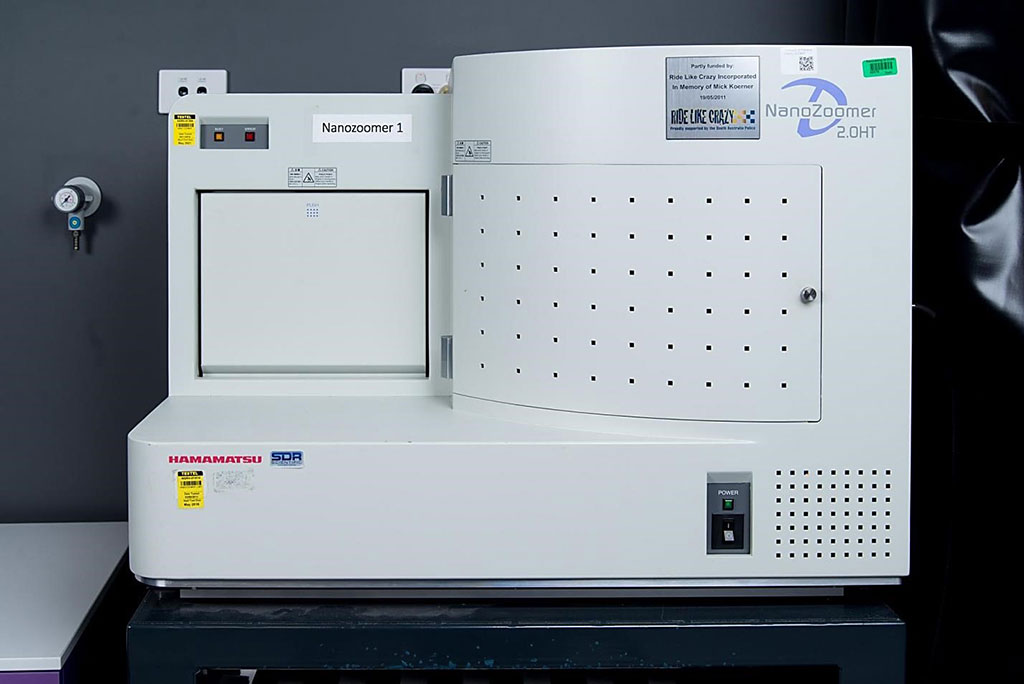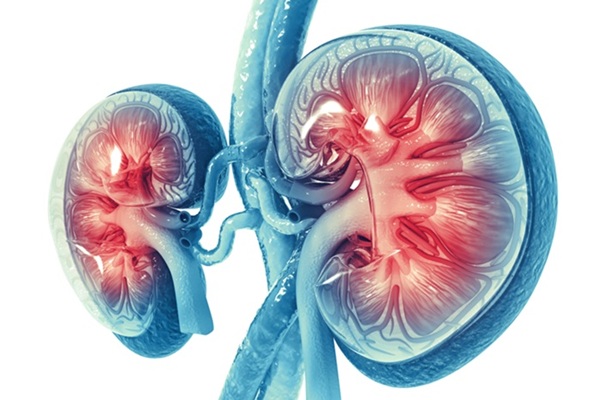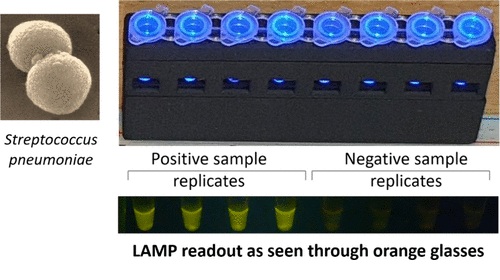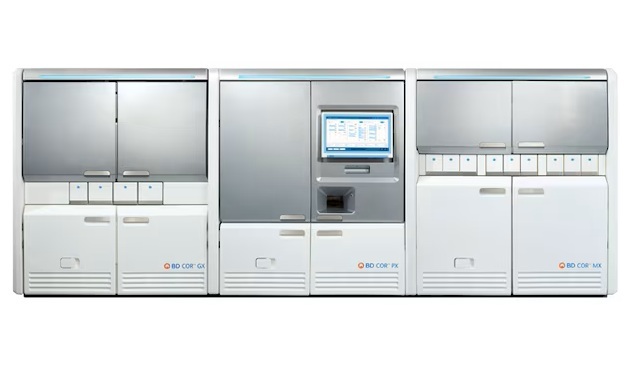Genetic Background and Clinicopathologic Features Established for Adult-Onset Nephronophthisis
|
By LabMedica International staff writers Posted on 06 May 2021 |

Image: The Hamamatsu Photonics Nanozoomer 1 Digital Slide Scanner (Photo courtesy of University of Adelaide)
Nephronophthisis (NPH) is a genetic disorder of the kidneys which mainly affects children. It is classified as a medullary cystic kidney disease. The disorder is inherited in an autosomal recessive fashion and, although rare, is the most common genetic cause of childhood kidney failure.
Even in adult patients, accurate diagnosis of NPH is important because management options, such as kidney transplantation and appropriate genetic counseling, are available. The clinical diagnosis of adult NPH is problematic because clinical, radiologic and histologic features are non-specific. Even the extrarenal features are fewer in adults. Because management includes renal transplantation and genetic counseling, an accurate early diagnosis is essential.
Nephrologists at the Tokyo Medical and Dental University (Tokyo, Japan) investigated 18 adult patients who were suspected to have NPH by renal biopsy. The patients were recruited at 16 institutions in Japan between 2015 and 2019. For each patient, the tissue slides that were stained with hematoxylin-eosin, periodic acid-Schiff, and periodic acid–methenamine silver were digitized using the NanoZoomer HT Scan system (Hamamatsu Photonics, Hamamatsu, Japan).
Comprehensive genetic testing was performed using capture-based next-generation sequencing of 69 genes that cause nine types of hereditary cystic kidney disease, including NPH, NPH-related ciliopathies (Joubert syndrome, Meckel syndrome, Senior-Løken syndrome, Bardet-Biedl syndrome, and skeletal ciliopathies), autosomal dominant polycystic kidney disease, autosomal recessive polycystic kidney disease, and autosomal dominant tubulointerstitial kidney disease.
The scientists performed polymerase chain reaction for exons 1, 10, and 20 of NPHP1, if homozygous entire deletion of NPHP1 was detected by copy number variation analysis. To investigate what the essence of thick tubular basement membrane (TBM) duplication was, they performed low-vacuum scanning electron microscopic (Hitachi, Tokyo, Japan) analysis and immunofluorescence (IF) analysis in the representative cases with or without pathogenic mutations.
The investigators reported that seven of 18 patients had pathogenic NPH-causing mutations in NPHP1, NPHP3, NPHP4, or CEP164. Compared with patients without pathogenic mutations, those with pathogenic mutations were significantly younger, but did not significantly differ in the classic NPH pathologic findings, such as tubular cysts. On the other hand, the number of tubules with thick TBM duplication, which was defined as >10-μm thickness, was significantly higher in patients with genetically proven adult NPH than in those without pathogenic mutations. α-Smooth muscle actin (α-SMA)-positive myofibroblasts were detected inside thick TBM duplication.
The authors concluded that in adult patients with NPH, thick TBM duplication was the specific finding. Their analysis also suggested that older patients tended to have no pathogenic mutations, even when they were suspected to have NPH by renal biopsy. These findings could be the novel clinical clue for the diagnosis of NPH in adult patients. The study was published originally on March 3, 2021 in the journal Kidney International Reports.
Related Links:
Tokyo Medical and Dental University
Hamamatsu Photonics
Hitachi
Even in adult patients, accurate diagnosis of NPH is important because management options, such as kidney transplantation and appropriate genetic counseling, are available. The clinical diagnosis of adult NPH is problematic because clinical, radiologic and histologic features are non-specific. Even the extrarenal features are fewer in adults. Because management includes renal transplantation and genetic counseling, an accurate early diagnosis is essential.
Nephrologists at the Tokyo Medical and Dental University (Tokyo, Japan) investigated 18 adult patients who were suspected to have NPH by renal biopsy. The patients were recruited at 16 institutions in Japan between 2015 and 2019. For each patient, the tissue slides that were stained with hematoxylin-eosin, periodic acid-Schiff, and periodic acid–methenamine silver were digitized using the NanoZoomer HT Scan system (Hamamatsu Photonics, Hamamatsu, Japan).
Comprehensive genetic testing was performed using capture-based next-generation sequencing of 69 genes that cause nine types of hereditary cystic kidney disease, including NPH, NPH-related ciliopathies (Joubert syndrome, Meckel syndrome, Senior-Løken syndrome, Bardet-Biedl syndrome, and skeletal ciliopathies), autosomal dominant polycystic kidney disease, autosomal recessive polycystic kidney disease, and autosomal dominant tubulointerstitial kidney disease.
The scientists performed polymerase chain reaction for exons 1, 10, and 20 of NPHP1, if homozygous entire deletion of NPHP1 was detected by copy number variation analysis. To investigate what the essence of thick tubular basement membrane (TBM) duplication was, they performed low-vacuum scanning electron microscopic (Hitachi, Tokyo, Japan) analysis and immunofluorescence (IF) analysis in the representative cases with or without pathogenic mutations.
The investigators reported that seven of 18 patients had pathogenic NPH-causing mutations in NPHP1, NPHP3, NPHP4, or CEP164. Compared with patients without pathogenic mutations, those with pathogenic mutations were significantly younger, but did not significantly differ in the classic NPH pathologic findings, such as tubular cysts. On the other hand, the number of tubules with thick TBM duplication, which was defined as >10-μm thickness, was significantly higher in patients with genetically proven adult NPH than in those without pathogenic mutations. α-Smooth muscle actin (α-SMA)-positive myofibroblasts were detected inside thick TBM duplication.
The authors concluded that in adult patients with NPH, thick TBM duplication was the specific finding. Their analysis also suggested that older patients tended to have no pathogenic mutations, even when they were suspected to have NPH by renal biopsy. These findings could be the novel clinical clue for the diagnosis of NPH in adult patients. The study was published originally on March 3, 2021 in the journal Kidney International Reports.
Related Links:
Tokyo Medical and Dental University
Hamamatsu Photonics
Hitachi
Latest Pathology News
- New Molecular Analysis Tool to Improve Disease Diagnosis
- Tears Offer Noninvasive Alternative for Diagnosing Neurodegenerative Diseases
- AI-Powered Method Combines Blood Data to Accurately Measure Biological Age
- AI Tool Detects Cancer in Blood Samples In 10 Minutes
- AI Pathology Analysis System Delivers Comprehensive Cancer Diagnosis
- AI Improves Cervical Cancer Screening in Low-Resource Settings
- New Multi-Omics Tool Illuminates Cancer Progression
- New Technique Detects Genetic Mutations in Brain Tumors During Surgery within 25 Minutes
- New Imaging Tech to Improve Diagnosis and Treatment of Skin Cancers
- Serially Testing Brain Tumor Samples Reveals Treatment Response in Glioblastoma Patients
- High-Accuracy Tumor Detection Method Offers Real-Time Surgical Guidance
- AI Tool Detects Hidden Warning Signs of Disease Inside Single Cells
- Automated Tool Detects Early Warning Signs of Breast Cancer
- New Software Tool Improves Analysis of Complex Spatial Data from Tissues
- AI Tool Helps Surgeons Distinguish Aggressive Glioblastoma from Other Brain Cancers in Real-Time
- New Tool Could Revolutionize Acute Leukemia Diagnosis
Channels
Clinical Chemistry
view channel
VOCs Show Promise for Early Multi-Cancer Detection
Early cancer detection is critical to improving survival rates, but most current screening methods focus on individual cancer types and often involve invasive procedures. This makes it difficult to identify... Read more
Portable Raman Spectroscopy Offers Cost-Effective Kidney Disease Diagnosis at POC
Kidney disease is typically diagnosed through blood or urine tests, often when patients present with symptoms such as blood in urine, shortness of breath, or weight loss. While these tests are common,... Read moreMolecular Diagnostics
view channel
New Diagnostic Method Detects Pneumonia at POC in Low-Resource Settings
Pneumonia continues to be one of the leading causes of death in low- and middle-income countries, where limited access to advanced laboratory infrastructure hampers early and accurate diagnosis.... Read more
Blood Immune Cell Analysis Detects Parkinson’s Before Symptoms Appear
Early diagnosis of Parkinson’s disease remains one of the greatest challenges in neurology. The condition, which affects nearly 12 million people globally, is typically identified only after significant... Read moreHematology
view channel
ADLM’s New Coagulation Testing Guidance to Improve Care for Patients on Blood Thinners
Direct oral anticoagulants (DOACs) are one of the most common types of blood thinners. Patients take them to prevent a host of complications that could arise from blood clotting, including stroke, deep... Read more
Viscoelastic Testing Could Improve Treatment of Maternal Hemorrhage
Postpartum hemorrhage, severe bleeding after childbirth, remains one of the leading causes of maternal mortality worldwide, yet many of these deaths are preventable. Standard care can be hindered by delays... Read more
Pioneering Model Measures Radiation Exposure in Blood for Precise Cancer Treatments
Scientists have long focused on protecting organs near tumors during radiotherapy, but blood — a vital, circulating tissue — has largely been excluded from dose calculations. Each blood cell passing through... Read moreImmunology
view channel
Blood-Based Liquid Biopsy Model Analyzes Immunotherapy Effectiveness
Immunotherapy has revolutionized cancer care by harnessing the immune system to fight tumors, yet predicting who will benefit remains a major challenge. Many patients undergo costly and taxing treatment... Read more
Signature Genes Predict T-Cell Expansion in Cancer Immunotherapy
Modern cancer immunotherapies rely on the ability of CD8⁺ T cells to rapidly multiply within tumors, generating the immune force needed to eliminate cancer cells. However, the biological triggers behind... Read moreMicrobiology
view channel
High-Throughput Enteric Panels Detect Multiple GI Bacterial Infections from Single Stool Swab Sample
Gastrointestinal (GI) infections are among the most common causes of illness worldwide, leading to over 1.7 million deaths annually and placing a heavy burden on healthcare systems. Conventional diagnostic... Read more
Fast Noninvasive Bedside Test Uses Sugar Fingerprint to Detect Fungal Infections
Candida bloodstream infections are a growing global health threat, causing an estimated 6 million cases and 3.8 million deaths annually. Hospitals are particularly vulnerable, as weakened patients after... Read moreTechnology
view channel
Cell-Sorting Device Uses Electromagnetic Levitation to Precisely Direct Cell Movement
Sorting different cell types—such as cancerous versus healthy or live versus dead cells—is a critical task in biology and medicine. However, conventional methods often require labeling, chemical exposure,... Read more
Embedded GPU Platform Enables Rapid Blood Profiling for POC Diagnostics
Blood tests remain a cornerstone of medical diagnostics, but traditional imaging and analysis methods can be slow, costly, and reliant on dyes or contrast agents. Now, scientists have developed a real-time,... Read moreIndustry
view channel
Qiagen Acquires Single-Cell Omics Firm Parse Biosciences
QIAGEN (Venlo, Netherlands) has entered into a definitive agreement to fully acquire Parse Biosciences (Seattle, WA, USA), a provider of scalable, instrument-free solutions for single-cell research.... Read more
Puritan Medical Products Showcasing Innovation at AMP2025 in Boston
Puritan Medical Products (Guilford, ME, USA), the world’s most trusted manufacturer of swabs and specimen collection devices, is set to exhibit at AMP2025 in Boston, Massachusetts, from November 11–15.... Read more
Advanced Instruments Merged Under Nova Biomedical Name
Advanced Instruments (Norwood, MA, USA) and Nova Biomedical (Waltham, MA, USA) are now officially doing business under a single, unified brand. This transformation is expected to deliver greater value... Read more






















